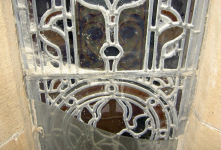Since Thursday October 13th I've been working onsite at St James Catholic Church in Woolley St, Forest Lodge, cleaning and restoring the three large stained glass windows behind the altar. Each set of windows is made up of three individual lancets, so nine windows in all, installed sometime around 1880.
 Scaffolding over altar
Scaffolding over altar
 External scaffold around the apse
External scaffold around the apse
 Rear of St James from the laneway
Rear of St James from the laneway
The job entailed firstly removing the wire guards to gain access to the windows and then completely removing all the old overglazing. This was in a terrible state, badly cracked and scoured and in fact should never have been installed in such a manner in the first place. When these windows were rebuilt some 40 or so years ago, the installers glazed a layer of protective glass hard up against the stained glass at the same time and in the same rebate. Consequently over the years huge deposits of debris had collected in the tiny space between the leaded glass and the overglazing, obscuring much of the beauty of the windows from the inside.
 Removing overglazing
Removing overglazing
 Trapped silt and overglazing
Trapped silt and overglazing
 External build up of silt
External build up of silt
Assisting me on the job are Clive Hillier (seen above) and Chris Wellwoood. Chris used to run Aurora Stained Glass at Narellan for many years. He currently runs a Life Drawing class for Liverpool Art Society. Clive operates Clive Hillier Stained and Art Glass now located at Kingsford. He previously taught leadlighting for many years at Australian Stained Glass Supplies when they were at Leichhardt and then Camperdown, (now primarily online sales, with a warehouse at Arncliffe) so the windows are in very good hands. The three of us are taking great care with the windows, spending long hours painstakingly cleaning each pane of glass both inside and out. There are also many small repairs to be done and just one panel requiring reconstruction. The last task will be to re-cement all the windows firmly into their stone rebates and re-hang the wire guards.
 Scraping away sludge
Scraping away sludge
 Obscured and damaged inscription panel
Obscured and damaged inscription panel
Restoration is a little like forensics or archeology and a good knowledge of many different studio practices is extremely useful in determining just what it is we are looking at. Painted stained glass windows tend to acquire an organic (I think) scum which builds up on the actual glass paint over the years. But in addition to this scum and accumulated cement render and house paint these windows were also covered in patches of black sludge.
In the making of a leadlight the final stage is to putty the gap between the glass and the lead with a glazing compound making them waterproof and binding the whole fabric together. Many studios use a slurry method to achieve this but effective clean-up is crucial with such a method and often this doesn't happen. Such was the case with the St James windows. When they were rebuilt sometime in the 1970's whoever applied the slurry left large clumps of the stuff adhered to the glass. A careful reading of the fired glass paint is required here to distinguish between sludge and the painted decoration hidden beneath. Fortunately the paint itself is quite strongly adhered to the glass (not always the case).
An advantage of having been rebuilt relatively recently (ie within maybe 20yrs or so) is that the lead fabric is quite sound so these windows should provide many more years of good service and the congregation will be able to appreciate their beauty anew once the scaffold comes down in a couple of weeks time.
